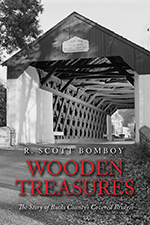In July 1929, James E. Sanders rolled into Perkasie to start a new factory that made miniature model ships. About nine months later, Sanders left town for good – and his mysterious past soon became common knowledge.
Calling himself “James Saunders,” he brought at least 40 new jobs to the old Perkasie Knitting Company building on Fourth Street near Chestnut Street that summer. His business, the Model Woodworking Company, was at first operating out of Sanders’ mother’s house in Philadelphia’s Powelton Village, with another facility near Girard College. Sanders arrived in Perkasie quietly and neighbors later said Sanders and his wife, Sarah, behaved well but did not take part in attending church or joining social groups in town. The same neighbors said it became known Sanders had resided in “Cherry Hill” before coming to Perkasie. At the time, Cherry Hill was the nickname for the Eastern State Penitentiary in Philadelphia, one of the world’s largest and most notorious prisons.
James E. Sanders was indeed a former convict, and not just any former convict. Under one of many aliases, Sanders (calling himself Louis C. Edwards) and five other inmates were the subject of a national manhunt after they broke out of the “state pen” in 1923. He made more headlines in Philadelphia in early 1929 when Sanders was pardoned with 18 years’ left on his sentence because he had started a successful model ship business inside the Eastern State Penitentiary. Sanders hired released prisoners to make ship models on the outside, giving them an alternative to their former criminal ways. His mother was the company’s president.
The man known in Philadelphia as “Edwards” was one of the city’s highest-profile criminals of the early 1920s. By 1922, “Lew Edwards” was a seasoned criminal who specialized in car thefts and escaping from prisons. Born in Illinois in 1892 as James Edward Sanders (not Saunders), Sanders’s father died in a train accident just before Sanders was born. His mother, Clara, moved to Missouri and remarried. James had worked as an auto mechanic, chauffeur, and an electrician when he was not in trouble with the law.
By 1920, Sanders’ mother lived in Philadelphia with her third husband, William Bierbower. Now going under the name of Louis C. Edwards, Sanders and three other men stole a car in Philadelphia and rode to Allentown, where they were confronted by a police officer. “Edwards” was taken to the Berks County jail after a brief shootout. While awaiting trial, Edwards engaged in a shootout with a prison guard after a fellow criminal, posing as a lawyer, smuggled a gun into Edwards’ cell. Both Edwards and the guard were wounded. Philadelphia detectives visited Edwards as he recovered and he willingly confessed to stealing 200 cars in his career, as well as taking part in robberies. However, the detectives were skeptical and believed Edwards was bragging to earn a “bad man” reputation.
A judge gave Edwards a 12-to-14-year sentence in the Eastern State Penitentiary, and his prison record, which is now available online, showed Edwards did indeed have a criminal past. State officials believed his real name was Louis Edwards, also known as James Edward Sanders, J.C. Porter, and Arthur Stewart. Edwards had served time on a Florida state work farm and a Georgia state penitentiary on larceny charges, and he had escaped from Georgia.
Edwards quickly adapted to life at Cherry Hill and spent his time planning his next escape. On July 14, 1923, Edwards and five other inmates overpowered two guards and scaled the walls of the state pen using a makeshift rope ladder. Using Edwards’ skills, they quickly stole a car, and drove south through Delaware and Maryland. During their flight, they robbed a family and kidnapped the driver of another car they stole.
The national manhunt was on for Edwards and the gang. In November 1923, a police officer in Hawaii recognized Edwards from the all-points bulletin sent around the country, and Edwards was arrested in Honolulu. During his flight west, Edwards had used his confidence skills to become a representative of the San Francisco Chamber of Commerce, and he was setting up an exhibition booth at the time of his arrest.
Back in Philadelphia, the court doubled Edwards’ jail sentence and he returned to Cherry Hill. State officials also confirmed that Edwards had escaped from the Florida work farm after just three months in April 1921 and Florida officials wanted to sentence Edwards to 20 years in prison once he did his time in Pennsylvania. However, Alfred W. Fleisher, a noted philanthropist and chair of the prison’s board, took an interest in Edwards. Fleisher strongly believed inmates could be rehabilitated if given a chance to do honest work and find new careers.
With Fleisher’s backing, Edwards learned woodworking and electronics, and by 1927, his Miniature Ship Models Company was in business, with a $5,000 investment from a bond issue. Customer orders were sent to the home of Clara Bierbower, Edwards’ mother, on Baring Street. By 1929, Edwards was now using the name James E. Saunders and he asked for a pardon as a model prisoner, which he received in February. By July 1929, Sanders and his wife, who was a prison case worker, arrived in Perkasie to start their own manufacturing plant outside of Philadelphia called the Model Woodworking Company.
The Sanders family rented rooms in Perkasie at the Frank Benner building on Arch Street near 7th Street and his business took over the unoccupied knitting factory on Fourth Street next to the former Crouthamel Clothing factory. The Perkasie Central News interviewed Sanders in July 1929. He told the newspaper the company had been in business for about 10 years, and it expected to employ 50 people in Perkasie once the factory’s machinery was installed.
In August 1929, a buzz grew in town when lumber arrived at the factory and the company advertised for workers. Sanders sought 30 girls to assemble model kits, and he needed to hire office staffers, a printer, and three woodworkers. Other “experienced help” had arrived from Philadelphia to help with the start-up process. But by November 1929, there were rumors in town that the Model Woodworking Company could shut down, which were denied by the company. The company kept busy for the holiday season and continued advertising its products in Popular Mechanics magazine.
Sanders also created a scene in Perkasie when he built a custom-built mobile home complete with a kitchen and sleeping space. He told Perkasie residents the couple was going to drive his car and the trailer to Florida for a vacation in January 1930. (Unknown to the locals, Sanders was still a wanted man in the Sunshine state.) The mobile home caught fire back in Perkasie after the road trip.
Then on January 25, 1930, the original Model Woodworking plant in Perkasie was mostly destroyed in a large blaze of unknown origins. It was the largest fire in Perkasie since 1922 and the company’s inventory of wooden models was lost in the fire. Its machinery and part of the lumber inventory survived in the factory’s basement. Sanders moved quickly to rent new space in Perkasie for his business, but he sold the company to Benjamin Moore of Lansdale in April 1930, and the family returned to Philadelphia. Moore renamed the company as Miniature Ship Models.
Little was heard about Sanders in Perkasie until February 1933 when news reached town that he had been arrested in Philadelphia and accused of running a crime syndicate with 25 members. Investigators believed Sanders lost $15,000 in a bank failure and had returned to a life of crime. At his trial, five of his alleged conspirators pled guilty. Sanders was steadfast in not admitting his guilt in court. Facing a new sentence of 35 to 70 years back at Cherry Hill, Sanders took the stand in his own defense. He denied leading a crime ring and said he often helped ex-convicts find new jobs, so it was natural for them to be at his mother’s house, where he still maintained a business. In the end, the jury found him guilty on nine counts and Sanders received a seven-year sentence. Sanders cried as he was led from the courtroom, and five women reportedly “swooned” when the verdict was read.
By 1940, Sanders was back at Baring Street in Powelton Village living with mother, Clara, and working as an electrician. Little is known about Sanders’ life after leaving the public spotlight. Sanders headed west in 1945 and he died in San Francisco at the age of 74 in 1967. He had been working as a locksmith at Yosemite Park before his death.
Today, the rebuilt Perkasie knitting factory and the Benner house remain in Perkasie’s town center, the only reminders of one of Perkasie’s more famous residents – if only for a brief time.
A special thanks to Debbie Moore for her help and research that filled in important gaps in this story.










